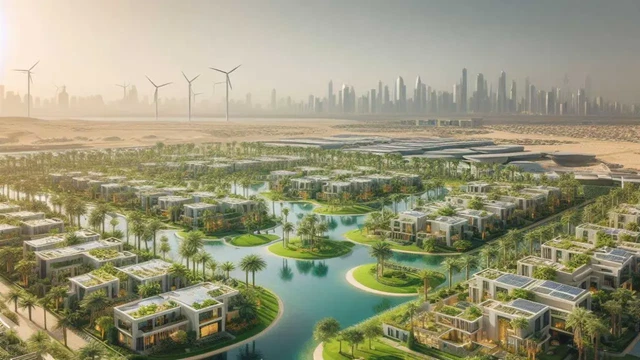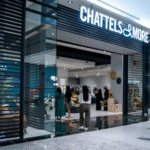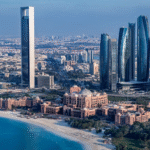Now Reading: Eco-Friendly Communities in the UAE: Growth & Future
-
01
Eco-Friendly Communities in the UAE: Growth & Future
Eco-Friendly Communities in the UAE: Growth & Future

The demand for eco-friendly communities in the UAE has grown rapidly over the last decade. Once known primarily for its glittering skyscrapers and luxury developments, the Emirates is now becoming a leader in sustainable living. Across Dubai, Abu Dhabi, and Sharjah, entire communities are being designed with green technologies, renewable energy, and eco-conscious lifestyles at their core.
This shift reflects more than just global trends. It highlights the UAE’s long-term vision to reduce its carbon footprint, diversify its economy, and create healthier environments for its people.
Why Eco-Friendly Communities Matter in the UAE
The UAE has one of the fastest-growing populations in the region, coupled with a large expatriate workforce. With rising demand for housing, traditional real estate models have often led to increased energy use, water consumption, and waste production.
Eco-friendly communities address these issues by focusing on:
- Energy Efficiency: Using solar power, smart grids, and energy-saving systems.
- Water Conservation: Recycling wastewater and using smart irrigation for landscaping.
- Sustainable Transport: Offering cycling lanes, electric vehicle (EV) charging stations, and walkable designs.
- Green Living: Encouraging organic farming, rooftop gardens, and eco-conscious lifestyles.
Pioneering Eco-Friendly Communities in the Emirates
1. The Sustainable City, Dubai
One of the UAE’s most famous green projects, The Sustainable City in Dubai, is a community that runs largely on solar power. It features:
- 500 villas powered by solar energy.
- Car-free zones and shared EV buggies.
- An urban farm producing organic fruits and vegetables.
- Waste recycling and water conservation systems.
It has become a model for other eco-communities around the world.
2. Masdar City, Abu Dhabi
Launched in 2008, Masdar City is one of the most ambitious eco-friendly developments globally. Designed as a hub for clean energy research and innovation, it includes:
- Net-zero energy buildings.
- Shaded pedestrian streets for cooler temperatures.
- Solar farms and wind towers for renewable energy.
- Universities, offices, and residential areas built with sustainability in mind.
Masdar City also serves as a testing ground for green technologies that can be applied worldwide.
3. Sharjah Sustainable City
Inspired by Dubai’s success, Sharjah Sustainable City is designed to bring eco-friendly living to a wider audience. It offers:
- Affordable green housing.
- Energy-efficient designs that cut utility bills.
- Smart home technologies.
- Urban farming initiatives to encourage self-sufficiency.
This project reflects how sustainability is expanding beyond Dubai and Abu Dhabi into other emirates.
4. Tilal Al Ghaf, Dubai
Developed by Majid Al Futtaim, Tilal Al Ghaf is a luxury community with sustainability at its heart. It includes a central lagoon with clean water technology, extensive green spaces, cycling and jogging tracks, and eco-conscious construction methods.
5. Aljada, Sharjah
While not exclusively marketed as an eco-community, Aljada has integrated sustainability features such as solar-powered public spaces, green parks, and smart transport systems, making it part of the growing eco-living trend.
The Role of Government in Supporting Eco-Friendly Communities
The UAE government has played a major role in promoting green developments. Initiatives such as the UAE Net Zero 2050 Strategy and the Dubai Clean Energy Strategy 2050 aim to:
- Generate 75% of Dubai’s energy from clean sources by 2050.
- Reduce carbon emissions across sectors.
- Support innovation in green construction and renewable technologies.
Policies such as building codes that require energy efficiency and incentives for green certifications (like LEED and Estidama) ensure that sustainability becomes standard practice.
Why Residents Choose Eco-Friendly Communities
For many residents, choosing eco-friendly communities is about more than sustainability. It also means:
- Lower Utility Costs: Solar power and efficient systems reduce electricity and water bills.
- Healthier Lifestyles: Cleaner air, organic farming, and active transport options create better living conditions.
- Community Engagement: Shared green spaces, eco-initiatives, and wellness-focused design encourage social interaction.
- Future-Proof Living: As sustainability becomes global policy, eco-communities ensure long-term value.

Investment Appeal of Eco-Friendly Developments
Eco-friendly communities are also becoming a hotspot for investors. Key reasons include:
- High Rental Demand: Many tenants, especially expats, prefer sustainable living.
- Premium Property Values: Green-certified buildings often command higher prices.
- Global Appeal: Eco-living attracts international investors who prioritize ESG (Environmental, Social, Governance) values.
- Government Support: Incentives and policy backing make such projects secure long-term investments.
Challenges to Widespread Adoption
While progress is impressive, eco-friendly communities face challenges such as:
- Higher Initial Costs: Green technologies often require bigger upfront investment.
- Awareness Gaps: Not all residents understand the benefits of eco-living.
- Scalability: Bringing sustainability to affordable housing remains a challenge.
However, with continued innovation and government support, these challenges are being addressed quickly.
The Future of Eco-Friendly Communities in the Emirates
The next wave of eco-friendly communities in the UAE will likely focus on:
- Smart Cities powered by AI and IoT for efficient energy and waste management.
- Carbon-Neutral Housing that reduces emissions entirely.
- Expanded Public Transport to reduce reliance on cars.
- Green Jobs & Innovation Hubs that connect residents with sustainable industries.
Projects like Dubai Creek Harbour, Zayed City in Abu Dhabi, and new Sharjah developments are already planning eco-conscious elements, ensuring that green living becomes mainstream across the Emirates.
Conclusion: A Green Future for the UAE
The growth of eco-friendly communities in the UAE is more than a trend – it is part of a national transformation. From The Sustainable City in Dubai to Masdar City in Abu Dhabi and Sharjah Sustainable City, these developments showcase how the Emirates is setting a global benchmark in sustainable living.
For residents, eco-communities offer healthier lifestyles and reduced costs. For investors, they promise long-term value. And for the UAE, they represent a commitment to innovation, resilience, and a greener future.
The Emirates is proving that luxury and sustainability can go hand in hand – creating communities that are not only modern and beautiful but also environmentally responsible.
Follow us on: Instagram
Read More:-Dubai Secondary Market Prices Soar as Sellers Push






















